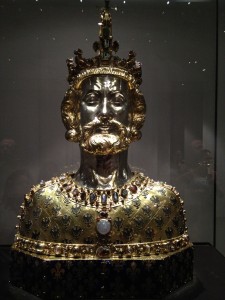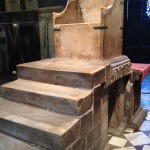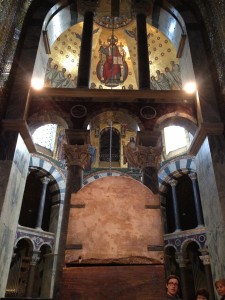
Yesterday, after leaving the castle of Godfrey de Bouillon in Belgium, we drove 2 hours to Aachen, Germany, where Charlemagne’s palace once stood, and the church he built still stands.
We began the day with a walk to the city centre where Charlemagne’s palace and church were located.
Aachen’s old town is a beautiful remnant of the Middle Ages, with restaurants and shops bordering narrow cobble stone streets.
At the center of the old town is it’s 8th century church.
We began, however, in the museum next door because it houses some of the most important remnants and possessions of Charlemagne.
By remnants, I mean parts of Charlemagne. The gold bust you see in the pic contains Charlemagne’s melon, and a gold reliquary in the same section of the museum contains a bone from Charlemagne’s wing.
This is all very macabre for sure but if you love history it’s fascinating to realize you are seeing the actual bones of Charlemagne.
The museum contains others relics, many obviously not authentic and others that were.

For example, one reliquary purportedly contained the sponge with sour wine offered to Jesus while on the cross. Ahh…I don’t think so. However, I dubbed it the “True Sponge” and of course got a pic.
Others in the I-don’t-think-so category included a splinter from the True Cross, and in the church, Mary’s (Jesus’s mother) cloak, Jesus’s swaddling clothes, the loin cloth worn by Jesus on the Cross and the cloth on which John the Baptist’s head was laid after his beheading.
I can only conclude they didn’t have consumer protection laws in the Middle Ages.
Aachen Cathedral is built around the structure Charlemagne erected in 792 A.D. The inside is magnificent. The rest of Charlemagne’s remains are in a large gold reliquary behind the altar in the church, although Ann and I had to use the process of elimination to determine what could have been left of him after what we saw in the museum.
What I found most interesting though was Charlemagne’s throne. It is still there in the church on the 2nd floor looking down on the congregation in the same place it was in 814 A.D. when he died.

I couldn’t miss the significance of this picture from behind the throne. Directly above the throne of Charlemagne on the ceiling is a mosaic of King Jesus on His throne. Charlemagne’s authority to rule was derived from King Jesus. (Romans 13:1).
From his throne, under King Jesus, Charlemagne looked out over his people, over whom he was to rule through the delegated authority from Jesus. It creates a picture that was not uncommon in the Middle Ages, though it became a bit twisted at times.
In Reims Cathedral there was a display with a quote that attempted to define the so-called divine right of kings. It read: “The king is the lieutenant of Jesus Christ in temporal matters, just as the Pope and his bishops are in a spiritual sense.”
The understanding of delegated authority represented by the so-called divine right of kings was at the same time too broad in its scope and too narrow in its application.
In the kingdom of God, all Christians, not just kings, operate under the delegated authority of King Jesus. That authority applies in every area of life in which kingdom citizens have responsibility for people, places and things. It doesn’t mean Christians are infallible in anything but it does mean they are responsible in everything to King Jesus.
At the end of a long day, we began the 5 hour drive back to Paris. GS
